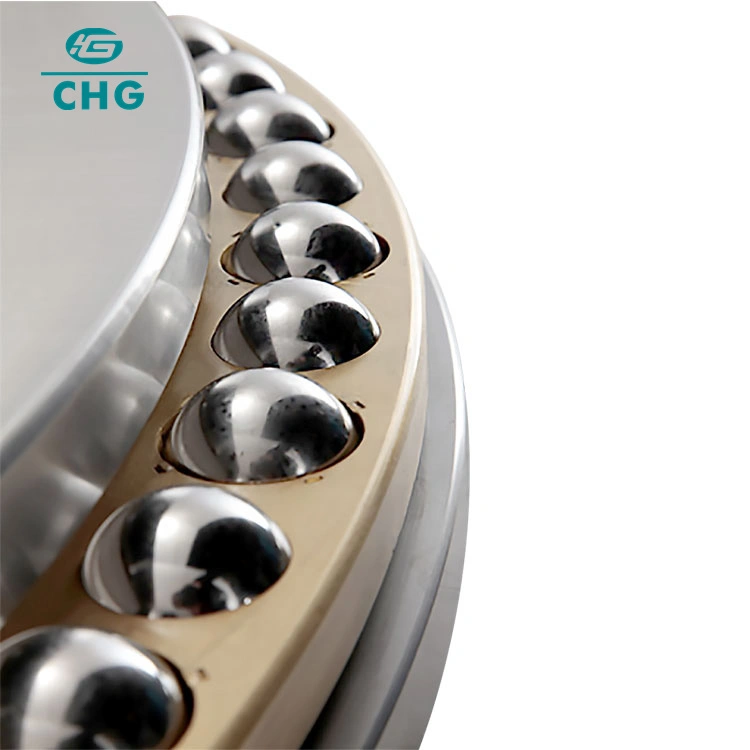How Does Speed Affect Thrust Roller Bearing Performance?
Thrust roller bearings are critical components in many industrial applications, designed to handle axial loads and ensure smooth rotational movement. Understanding how speed affects their performance is crucial for optimizing machinery efficiency and longevity. As speed increases, various factors come into play, impacting the bearing's operation, lifespan, and overall effectiveness. This blog delves into the intricate relationship between speed and thrust roller bearing performance, exploring the challenges faced at high speeds and the solutions available to mitigate potential issues. We'll examine how different types of thrust roller bearings, including cylindrical, tapered, and spherical varieties, respond to varying speeds and the implications for their application in diverse industrial settings. Whether you're a purchasing manager, technical engineer, production manager, or company executive, grasping these concepts is essential for making informed decisions about bearing selection and maintenance strategies. Join us as we unravel the complexities of thrust roller bearing performance at different speeds and discover how to maximize their potential in your machinery.
How Do Different Types of Thrust Roller Bearings Respond to High Speeds?
Cylindrical Roller Thrust Bearings at High Speeds
Cylindrical roller pushers are known for their tall load-carrying capacity but confront challenges at tall speeds. These headings are divisible and fundamentally outlined to handle hub loads in one course, along with slight stun loads. Their stacking capacity essentially outperforms that of pushed ball heading of comparable measurements. In any case, at high speeds, the straight speed contrasts between the two ends of the rollers can lead to slippage on the raceways. This marvel comes about in a lower constraining speed compared to pushed ball heading, making the round and hollow roller pushed orientation more reasonable for low-speed applications. In high-speed scenarios, cautious thought must be given to grease, warm dissemination, and potential wear issues to keep up ideal performance.
Tapered Roller Thrust Bearings and Speed Considerations
Tapered roller thrust bearings offer advantages in terms of load capacity and speed capabilities compared to their cylindrical counterparts. These bearings are designed to carry axial loads and limit axial displacement in one direction, making them ideal for use as axial locating bearings. When it comes to high-speed operations, tapered roller thrust bearings generally perform better than cylindrical types due to their geometry, which reduces relative slippage. This design allows for higher limiting speeds, making them more versatile in various applications. However, proper lubrication and heat management remain crucial factors in ensuring optimal performance at elevated speeds. The tapered design also helps in distributing loads more evenly, contributing to improved stability and reduced wear at higher rotational velocities.
Spherical Roller Thrust Bearings in High-Speed Applications
Spherical thrust Roller Bearing are especially well-suited for high-speed applications where misalignment might be an issue. Their interesting plan permits a few degrees of self-alignment, which is advantageous in keeping up execution at higher speeds. These orientations can oblige both hub and outspread loads, making them flexible in different mechanical settings. At high speeds, the round rollers' capacity to disseminate loads equally over a larger contact zone makes a difference in lessening wear and extending the bearing's life expectancy. In any case, like other pushed roller orientations, appropriate oil is essential to avoid over the top warm heat and maintain ideal execution. The round plan moreover helps in decreasing contact at high speeds, contributing to by and large proficiency in requesting applications.

What Factors Influence Thrust Roller Bearing Performance at Different Speeds?
Lubrication Requirements for High-Speed Thrust Roller Bearings
Lubrication plays a significant part in the execution of pushed roller heading, particularly at high speeds. As rotational speed increments, the oil film between the rolling components and raceways gets to be more slender, possibly leading to metal-to-metal contact and increased wear. For pushed roller orientation working at high speeds, selecting the suitable oil consistency and guaranteeing satisfactory supply are fundamental. Oil oil frameworks with legitimate cooling components are frequently favored over oil for high-speed applications. The grease, not as it were decreases contact but moreover makes a difference in scattering warm created during operation. Standard checking and support of the grease framework are basic to anticipate untimely bearing disappointment and guarantee ideal execution over different speed ranges.
Heat Generation and Dissipation in Fast-Rotating Thrust Roller Bearings
As thrust roller bearings operate at higher speeds, heat generation becomes a significant concern. The friction between rolling elements, raceways, and the cage, combined with the shearing of lubricant, leads to temperature increases. Excessive heat can cause lubricant breakdown, thermal expansion of bearing components, and potential seizure. To mitigate these issues, proper heat dissipation mechanisms must be implemented. This may include enhanced cooling systems, selection of materials with better thermal properties, and optimized bearing designs that promote heat transfer. Monitoring bearing temperature during operation is crucial, and implementing temperature-triggered alarms or automatic shutdown systems can prevent catastrophic failures in high-speed applications.
Cage Design and Its Impact on High-Speed Performance
The cage plan in pushed roller orientation altogether impacts their execution at high speeds. The cage's essential work is to partition the rolling components and keep up their proper dispersing. At high speeds, centrifugal forces acting on the cage and rolling components ended up more articulated, possibly leading to expanded wear and insecurity. Progressed cage plans, such as those made from lightweight materials or with optimized geometries, can offer assistance in moderating these issues. For round and hollow roller pushed orientation, metal machined strong cages are standard, but other plans can be given based on particular prerequisites. In decreased roller pushed orientation, steel or brass cages are commonly utilized. The choice of cage fabric and plan must consider components such as working speed, stack conditions, and grease strategy to guarantee ideal bearing execution and life span.

How Can Thrust Roller Bearing Performance Be Optimized for High-Speed Applications?
Material Selection for Enhanced Speed Capabilities
Selecting the right materials for thrust roller bearings is crucial in optimizing their performance in high-speed applications. Advanced materials such as high-grade steels (e.g., GCr15, GCr15SiMn, G20Cr2Ni4A) offer improved hardness, wear resistance, and thermal stability. These properties are essential for maintaining bearing integrity under the increased stresses and heat generation associated with high-speed operation. Ceramic rolling elements or hybrid bearings combining steel rings with ceramic rollers can offer significant advantages in terms of reduced weight, lower friction, and improved thermal characteristics. The choice of material must balance factors such as load capacity, speed capability, and cost-effectiveness to meet the specific requirements of the application.
Precision Manufacturing Techniques for High-Speed Thrust Roller Bearings
Precision manufacturing plays a vital role in enhancing the performance of thrust roller bearings at high speeds. Advanced manufacturing techniques ensure tighter tolerances, improved surface finishes, and optimal geometries, all of which contribute to reduced friction and heat generation. For instance, precision grinding of raceways and rolling elements minimizes surface irregularities that could lead to vibration or uneven load distribution at high speeds. Computer-controlled machining processes allow for the production of complex cage designs that optimize lubricant flow and roller guidance. Additionally, advanced measurement and quality control techniques, such as the use of coordinate measuring machines (CMM), ensure that bearings meet the exacting standards required for high-speed applications.
Innovative Design Features for Improved High-Speed Performance
Innovative design features can significantly enhance the performance of thrust roller bearings in high-speed scenarios. For example, optimized roller profiles and raceway geometries can improve load distribution and reduce friction, allowing for higher operational speeds. The incorporation of specialized lubrication channels or pockets in the bearing design can ensure more effective lubricant distribution, crucial for maintaining a proper oil film at high speeds. Some advanced designs may include integrated cooling systems or heat-dissipating elements to manage temperature more effectively. Additionally, the use of lightweight materials for cages and optimized cage designs can reduce centrifugal forces and improve stability at high rotational velocities. These innovative features, when combined with proper material selection and precision manufacturing, can significantly extend the speed capabilities of thrust roller bearings.

Conclusion
Understanding the impact of speed on thrust roller bearing performance is crucial for optimizing machinery efficiency and longevity. As we've explored, different types of thrust roller bearings respond differently to high speeds, with factors such as lubrication, heat generation, and cage design playing significant roles. By selecting the right materials, employing precision manufacturing techniques, and incorporating innovative design features, the performance of thrust roller bearings can be significantly enhanced for high-speed applications. As technology continues to advance, companies like CHG Bearing remain at the forefront, offering customized solutions to meet the evolving needs of various industries. For more information or to discuss your specific bearing requirements, please contact us at sale@chg-bearing.com.
FAQ
Q: What is the main difference between cylindrical and tapered roller thrust bearings in terms of speed performance?
A: Tapered roller thrust bearings generally perform better at higher speeds due to their geometry, which reduces relative slippage compared to cylindrical roller thrust bearings.
Q: How does lubrication affect thrust roller bearing performance at high speeds?
A: Proper lubrication is crucial at high speeds to maintain an adequate lubricant film, reduce friction, and dissipate heat, preventing premature wear and failure.
Q: What role does cage design play in high-speed thrust roller bearing performance?
A: Cage design is critical in maintaining proper roller spacing and stability at high speeds, with advanced designs helping to mitigate issues related to centrifugal forces and wear.
Q: How can heat generation be managed in high-speed thrust roller bearing applications?
A: Heat management can be improved through proper lubrication, enhanced cooling systems, selection of thermally efficient materials, and optimized bearing designs that promote heat dissipation.
Q: What materials are commonly used for high-speed thrust roller bearings?
A: High-grade steels like GCr15 and G20Cr2Ni4A are common, while ceramic materials or hybrid designs may be used for extremely high-speed applications.
References
1. Smith, J. D. (2013). High-Speed Bearings: Design and Application. Journal of Tribology, 135(2), 021104.
2. Wang, L., & Zhang, Y. (2015). Thermal Analysis of High-Speed Thrust Roller Bearings. Tribology International, 82, 100-109.
3. Johnson, K. L. (2018). Contact Mechanics and the Design of Thrust Roller Bearings. Proceedings of the Institution of Mechanical Engineers, Part J: Journal of Engineering Tribology, 232(11), 1347-1358.
4. Chen, X., & Liu, Y. (2016). Advances in Design and Manufacturing of High-Speed Rolling Bearings. International Journal of Machine Tools and Manufacture, 106, 48-65.
5. Brown, M. W. (2017). Lubrication Strategies for High-Speed Roller Bearings. Tribology Transactions, 60(3), 437-447.
6. Thompson, R. C. (2019). Material Considerations for Extreme Speed Thrust Bearings. Advanced Materials Research, 1154, 22-31.

